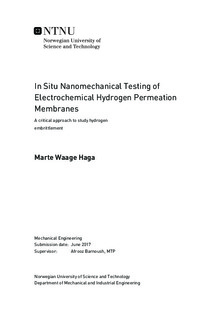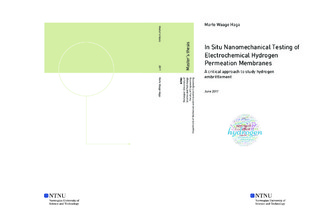| dc.description.abstract | The purpose of this thesis is to determine if the new novel approach of investigating the effects of hydrogen, using a custom made hydrogen permeation cell together with a nanoindenter can give insight into the fundamental mechanism of hydrogen embrittlement. The sample used in this experiment is mainly an Fe3%Si sample. Similar work involving in situ nanoindentation and micro-cantilever bending has shown changes in material behavior such as change in pop-in load and crack propagation in the presence of hydrogen. These experiments have been charging the samples by covering the indentation surface with an electrolyte and charging it as a one sided permeation cell. For this experiment the electrolyte is moved to the opposite side of the indentation surface. By doing so one can remove any contributing effect of the electrolyte on the indentation surface and only measure the effect of the hydrogen by charging the sample with hydrogen while indenting. During the fall of 2016 a custom made electrochemical cell was designed and manufactured for this purpose.
In addition to the nanoindentation, two experiments using microindentation is also performed. By indenting deeper the hydrogen concentration should be higher based on the theory of linear hydrogen concentration gradient through the sample during steady state charging. Calculations based on a similar experiment done in 2015 reveal that the concentration at the nanoindentation depths are very low compared to the charging surface and is the main limit of this approach. An other concern is the functionality of the cell. In order to determine if there was any hydrogen diffusing through the sample with this cell, a full permeation experiment was also conducted.
Neither the nanoindenation nor the microindentation produced any reproducible changes after the hydrogen charging. In addition to this it was found that the pop-in load can vary greatly within one grain, something that raises questing whether or not the pop-in load is a good measure of change due to hydrogen effect for Fe3%Si. The full permeation experiment gave inconclusive results about the functionality and requires further work to be determined. Based on this information it has been concluded that the hydrogen concentration at the indentation depths are too low to have an effect which can be measured with this approach, even if the cell should be proven to function. For future work an effort should be made to determine the functionality of the cell, as well as figure out how high the hydrogen concentration should be in order to measure an effect. Based on this specific experimental parameters can be determined (Sample thickness, charging current, electrolyte etc.). | |

